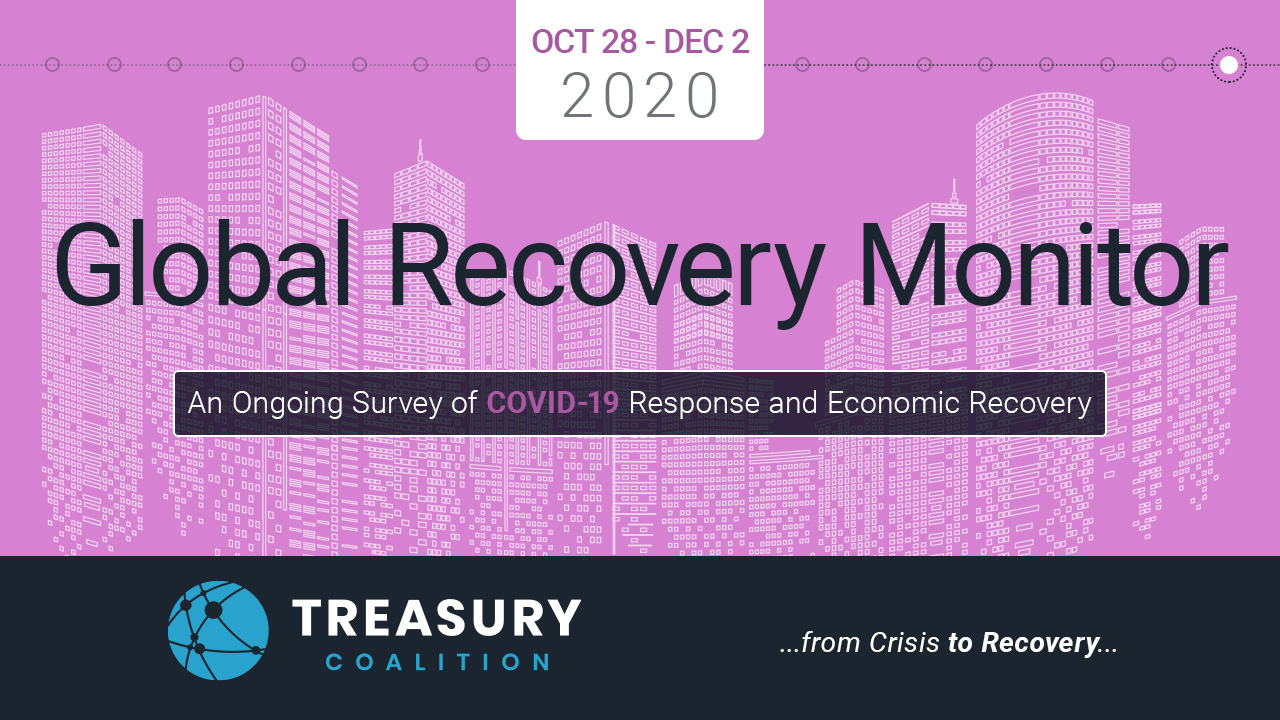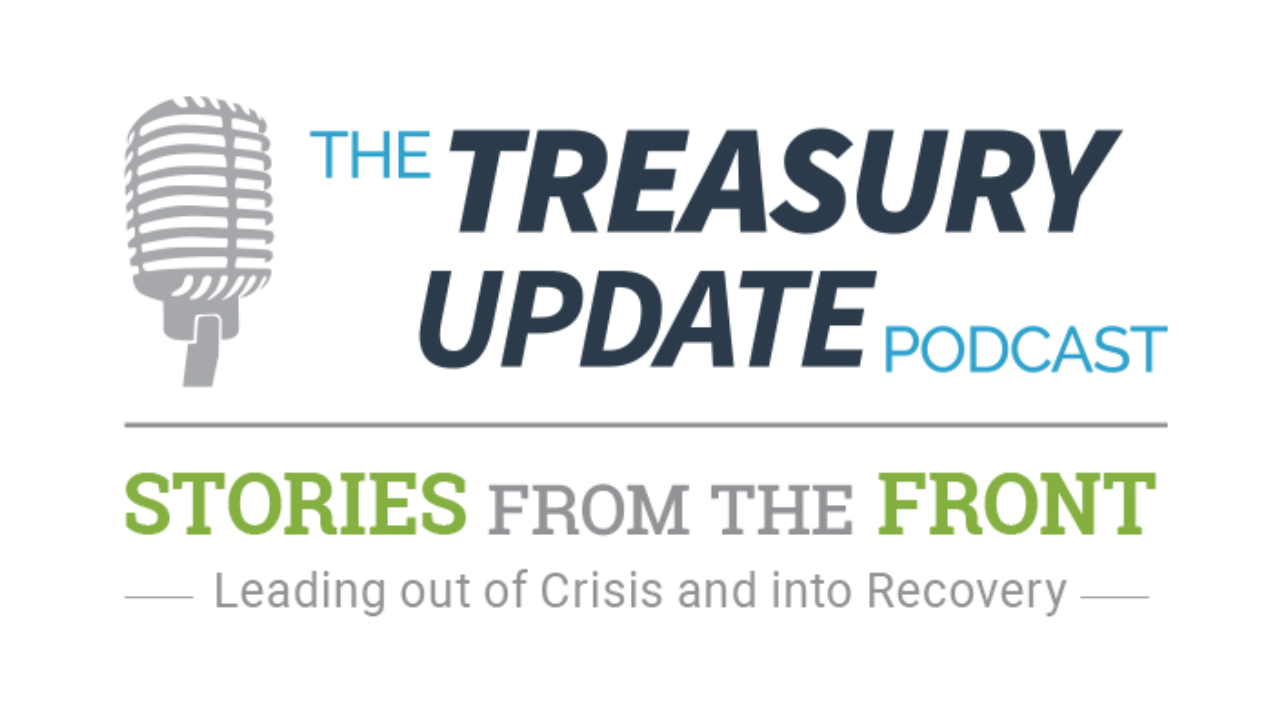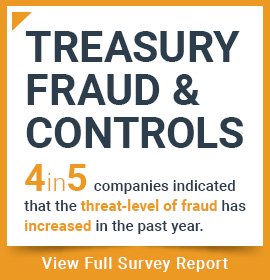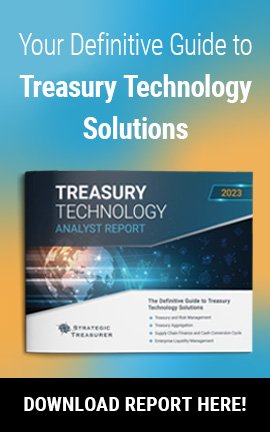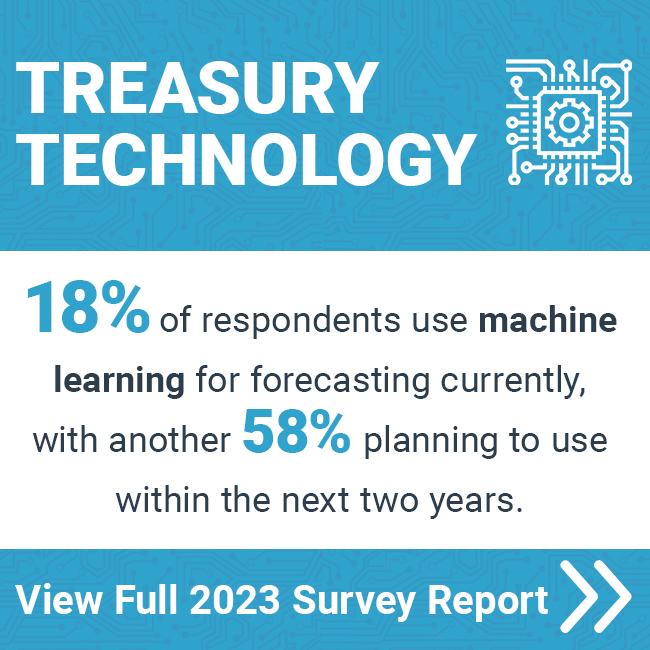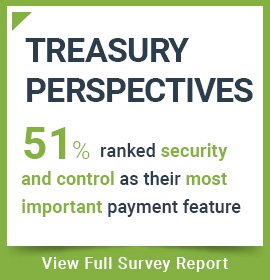
Episode 121
Stories from the Front:
Accelerating Towards the Future State with Leading Processes
On this episode of the Stories from the Front series, Host Craig Jeffery joins Jonathan Paquette, Sr. Financial Solutions Expert, and Kevin Rice, Sr. Customer Success Manager of Treasury Intelligence Solutions (TIS), to discuss accelerating towards the future state with leading processes. The discussion centers around learning from challenges through customer case study examples showcasing global logistics and manufacturing companies, leading practices for addressing resource restrictions and technology roadblocks, and key insights for effectively assessing and implementing processes across various projects. Listen in to this engaging conversation to find out more.
Host:
Craig Jeffery, Strategic Treasurer


Speaker:
Jonathan Paquette, TIS
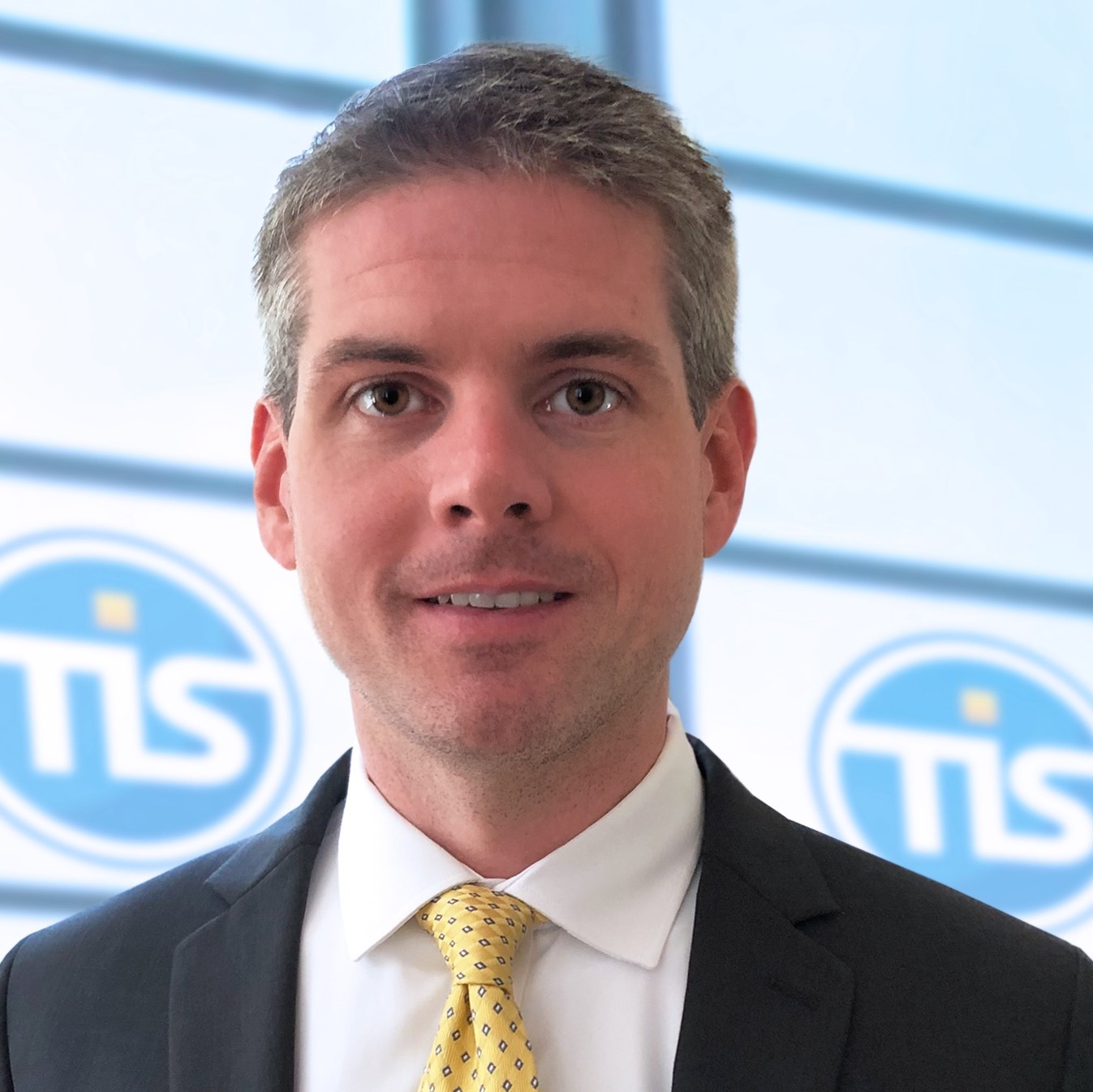

Speaker:
Kevin Rice, TIS


Subscribe to the Treasury Update Podcast on your favorite app!
Episode Transcription - Episode 121 - Stories from the Front: Accelerating Towards the Future State with Leading Processes
Craig Jeffery:
Welcome to the Treasury Update Podcast. Today’s episode is titled Accelerating Towards The Future State With Leading Processes. And this is part of the stories from the front series, Leading Out Of Crisis And Into Recovery. I’d like to welcome John Paquette and Kevin Rice from TIS to today’s episode. Welcome.
Jonathan Paquette:
Thanks Craig. Thanks for having us.
Kevin Rice:
Thanks Craig.
Craig Jeffery:
So John has been on the podcast before. He’s a senior financial solutions expert at TIS, and we’re glad to have him back. And Kevin is a first time on the Treasury Update Podcast. He’s a senior customer success manager and recently joined TIS, but let’s get into our discussion. And I want to begin with this concept of learning from challenges. I think we all know that challenges can be very different or unique, but they can also be common from one company to another. And we can oftentimes learn from these common or share challenges and how we approach them. So we talked about, in preparation for today’s episode, we talked about some case study examples that each of you would be covering. And John, maybe you could do a quick intro on the type of company you’re going to be focused on and Kevin as well.
Jonathan Paquette:
Yeah sure. So one case I thought might be interesting to discuss is one of our customers, they’re big global logistics company, a big international footprint, serve over 130 countries across the world. They became one of our customers late last year. And at the time that they joined us, they had a treasurer that recently joined the organization as well. Prior to that point, prior to that individual joining, they actually had no formal treasury department, which is interesting. They really had little to no financial process automation and really a transaction heavy environment. There was both a lot of outgoing payments to execute globally and a lot of transactions to reconcile.
Jonathan Paquette:
So, for this particular organization, visibility was critical. Both in cash visibility, knowing where the cash was, and also visibility over the payments process because they had somewhat of a downstream process where they had to proactively notify the beneficiaries of certain payments that they had been sent and executed through providing transaction reference numbers. This then allowed those beneficiaries to release certain time critical shipments. To solve all these challenges the organization was looking to move to straight through processing globally, automate the full cash applications process and really gain automation over this payment settlement process. So, TIS role in this was really to be the connectivity hub that really facilitated the communications with the banks and drove the automation for the downstream processes.
Craig Jeffery:
Yeah. Excellent. The growing complexity. I liked the example of didn’t have a formal treasury department at the time. Kevin, can you tell us a little bit about the company you’re going to be describing from a challenge position?
Kevin Rice:
Sure. Thanks Craig. Also, one of our customers, global manufacturer. They operated in a very decentralized environment. As a company had little control over their global cash management processes. Their key problem was a lack of visibility and transparency with regard to their cash flows. And there was really a need to streamline and centralize these operations. The treasurer at this manufacturer really set forth a goal to achieve control and establish 100% visibility across the organization.
Craig Jeffery:
Yeah. And maybe I could just ask a few follow-up questions there Kevin. So you talk about decentralized and I guess a decentralized process for seeing everything. I think we all know that treasury or most of us know that treasury systems, for example, work well on a centralized basis for seeing cash and liquidity. They tend not to do very well in this decentralized view, but what are some of the complexity elements or issues that they had beyond that? Maybe some of the size and scale of their treasury operation.
Kevin Rice:
Again, sticking with that concept of cash visibility. The company really had less than 40% across the entire organization. And as a highly leveraged company, they always had an initiative to pay down debt. And when you don’t have the ability to really determine a global cash position and understand how your cash is distributed across the organization, that makes that a very difficult task. Beyond that the company was always dependent on people dependent environment. Being dependent on finance managers across the globe, communicating those balances to corporate treasury to really drive that initiative. There was no sense of unification and really contributed to that lack of visibility. And to complicate things further you’re talking about dealing with 40 banks across this entire company. They had a large global footprint, there were multiple channels involved to gather this information. To really have one central source was really a goal for this company.
Kevin Rice:
And their back office system situation, that landscape was complicated as well. We’re talking about dealing with over 15 different ERP systems and to bring that all together was really a complicated process for the company. And they really weren’t sure how to approach it. As a result all of this really contributed to that decentralized environment I mentioned earlier. To that point, a lot of the subsidiaries were really operating on their own terms. There was no streamlined processes with regards to cash management and that’s something that needed to be addressed.
Craig Jeffery:
Yeah, this idea of everyone’s operating decentralized each local area, local finance person is making their own calls. We’ve always seen that people keep way too much cash on hand because they’re making the decision, whether they let’s say send it up to headquarters, they’re concerned they won’t have enough cash or they’ll run into a problems. Was that a factor at all or?
Kevin Rice:
Absolutely. Yeah. Each month period and quarter end. We were analyzing our balance sheet and realizing we’re sitting on this excess cash while we’re holding this large amount of debt. But that was just it. We really didn’t have the means to understand where that cash was or even the ability to really get that cash out. This company constantly ran into that issue.
Craig Jeffery:
A couple questions you mentioned they had around 40 banks, your case say 40 banks. And then you had mentioned something. I just wanted to ask what that meant when you said 40%. And I think you were talking about visibility. Was that 40% visibility to all of the banks or was it 40% of all the cash balance? Right? Some banks are more cash heavy than others. When you said 40% what was that referring to?
Kevin Rice:
Yeah. Well when you think about it in the grand scheme of things, it’s really, really both. 40% of the banks and the way that the cash is distributed in that company is really 40% of the global cash flow as well because they had such a large footprint, their global cash position was dispersed pretty broadly. And that created a lot of challenges for the company in terms of having to move cash through multiple channels in order to get it back to corporate. To again make the best use of that cash to pay down their debt.
Craig Jeffery:
Thanks for clarifying that. Certainly in a number of challenges, there are many organizations run into this complexity, you grow you’re in more countries and what was slightly inefficient becomes massively inefficient when you get there. And to be fair with time John the issues that your example, the global logistics company, what were some of their challenges or constraints? You started us on that but I wanted to get a little more detailed to know about them and also for the listeners.
Jonathan Paquette:
Yeah, sure. So I think first of all, it was just an overall big project scope, right? This organization was really looking to automate elements of the Procure-to-Pay process, the cash applications process. So huge scope to undertake and obviously IT resources is strained at every organization, right? So really just figuring out how to slot the right IT resources into this project to be able to address this large project scope, I think was the complexity. Likewise, I mentioned how spread out they were geographically, right? 130 countries so that made things quite complex from a banking standpoint. There was a lot of different bank specific protocols to address, bank formats and things like that to ultimately drive the level of automation that they hope to achieve within the organization. And then overall they were decentralized as well, right? So they basically had three processing centers that were supporting each of their three regions with a separate treasury team for each one of those regions. So a lot to orchestrate in terms of both project resources, processes, IT resources to kind of get this whole process in sync globally.
Craig Jeffery:
Yeah. You talked about complexity, you mentioned 132 countries, Kevin mentioned 40 banks and 15 ERP systems. Well, how many ERP systems Jon is your case study? What were they working with?
Jonathan Paquette:
So that was probably the one benefit of this particular project, is alongside the project that we’re also doing a migration to a single ERP. So luckily complexity internationally with the banking landscape, but not on the ERP side.
Craig Jeffery:
Excellent. Well that is simpler. I always am a bit suspicious when people say they’re migrating to a single ERP because they’re always acquiring other companies and you rationalize one system away. And in the meantime you’ve bought two more companies. So it’s almost a never-ending complexity, but that’s a great example there. And yeah, I wanted to talk about this idea of visibility and both of you talked about it as this is something that they wanted to have and it’s almost become a standard of a minimally accepted standard that you should be able to see all of your cash from all of your accounts all at once. And so I wanted to talk about this concept of leaning practices that this would be considered leaning, but also to some extent a minimum standard of being able to see all your cash around the globe. And then to discussing this concept of leaning practices, not just related to seeing all your cash, but a couple other areas. And then talk through how those two different types of companies, logistics and manufacturing, address the different constraints or gating items on these.
Craig Jeffery:
I don’t know, when you guys looked at this and this is a good example of someone else comes in to assess a situation and says, “Okay, I’ve seen this before. I know how we solve it.” But maybe we could talk about some aspects about resource restrictions. How do you solve those types of issues? Because you can’t necessarily make a company just hire a bunch of people for one-time projects. And what’s a good way of doing that? And what did you see Jon for addressing resource restrictions and what would you say would be leading practices in those areas?
Jonathan Paquette:
Yeah. So for this particular project, I did mention there was a strain on internal IT resources, particularly because the project scope is so large, right? And that’s not an area that’s particularly easy to flex up. And likewise, the project team was able to identify few areas where there was really kind of mission critical IT processes. One point would be the bank connectivity, right? So really navigating the bank connectivity aspects and developing all the bank country specific payment formats. These types of elements were critical to the project because the bank connectivity was really the engine that drove the downstream automations, right? So in this case, I think the project team had good foresight to see that this was a particular area where they maybe didn’t have the specialized knowledge internally and might be a good place to kind of supplement their internal resources with some external resources that were more specialized in this area, right? And this instance, it was a good way to stretch the organization’s IT resources, lift a really heavy component of the project off the shoulders of the project team and ultimately have a smoother path through their automation goals.
Craig Jeffery:
Jon, thanks for jumping into that. And so, what I was hearing you say too, as part of the resource restrictions might be knowledge, ability to do something that might be done once in a career every so many years, they may not have the knowledge, but also the ability to have resources to, like you said, flex up, have the time to do those. So that seemed to address those two concerns. Was there something else in that or is that?
Jonathan Paquette:
No, I think that those are the key points there, as well as just the thorough project scoping and assessment to understand the areas where there could potentially be roadblocks and particularly on the technical land where the internal team might not have the knowledge to really address something efficiently, quickly in a cost effective way. Those are the key areas to really look to when trying to identify areas. We can supplement your internal it resources with some external resources.
Craig Jeffery:
Great. Thanks. Yeah. Scoping the resources. Now I’m going to turn it back to Kevin with your case study but there’s one thing about not having enough resources but not all the time when there’s something new or changes going on are people excited about it. There can be some resistance. If I’m putting change in place, I’m excited about it. If change is being put in place to me, I may be somewhat resistance. But you’re dealing with very decentralized environment and this may be seen as a loss of ownership. So maybe you can tell us what you see with regard to change management or just ways of reducing the natural resistances out there in anytime there’s a change.
Kevin Rice:
So I think it’s important anytime that you are implementing a technology solution that you think about it from two perspectives, the end users that are going to be leveraging that piece of technology and then also the personnel that is going to be involved in terms of implementing that technology. And you really want to do a good job of identifying the key stakeholders in that project. And doing that because you want to get input from everyone involved that really helps the decision makers whoever’s driving the project really think outside of the box. And when you do that, you can gain support from other departments that really help get the overall initiative across the finish line. With regards to your question on change management and kind of how that works into the conversation. I think conveying the immediate benefits and future return on investment to senior management is critical to get their buy-in. Because at the end of the day, if your CFO or treasurer is not on board with what you’re doing, there’s no opportunity for kind of a global rollout so to say with regards to a global rollout.
Kevin Rice:
Another opportunity that most companies or approach rather that most companies take, are rolling out a pilot program as sort of a probationary period for this technology. And that’s done to test the waters before scaling such a technology solution. You want to prove it’s a viable solution. You want to be able to go to multiple business units across the entire organization to say, “Hey we put this in place with business unit A and it’s proved successful. These are the cost savings that we’ve realized. And the benefits that come with. This would be a great fit for you. If you feel otherwise please help us understand why.”
Craig Jeffery:
Thanks for explaining that and talking about the pilot program and how that ensures additional buy-in. Are there any other things that you found either in this case study or others that help bring people along? Maybe not at the top of the house, getting executive buy-in, but people who may be concerned about, “Hey, you’re moving my cheese, you’re changing how my job looks or you’re automating something that I used to do.” Any thoughts on that?
Kevin Rice:
Yeah. Well, again, as part of the the project scope and before you get started on anything you really do need to understand kind of what’s going on across your organization, how people are operating on a day-to-day basis, whether it’s for payments or reporting, how are they getting their information? What are the channels that they’re going through? Is this an opportunity to make their day-to-day life easier? And then the organization as a whole can benefit from it. That’s really where your starting point should be in this whole process, is understanding the needs across the organization at the local level, rolling right up to the corporate level. So the goal I think when people implement a piece of technology is to really unify a process, right? If you have the ability to streamline something across your entire company, I think that’s something most people don’t overlook.
Craig Jeffery:
Good point. Thanks Kevin. I’m going to keep going back and forth. So Jon, you’re up next. When we talk about some different activities, you talked about procure-to-pay, your part of the cash conversion cycle. Maybe you could talk a little bit about how these changes were handled, that impacted third parties, right? If you talk about procure-to-pay, there’s a third party, who’s a critical business partner, and these are crucial processes for them too. Making change, impacts others outside your scope of control directly, right? It’s suppliers or customers. So maybe you could share if there’s any learning in that area.
Jonathan Paquette:
Yeah. That’s a great point. There’s a third party that’s impacted as well, and that’s a pretty business critical process as well in terms of how that part is being paid or what information they’re being given overall, right? So I think that that’s one thing that this particular customer did quite well. They did a thorough scoping to really understand the full scope of the project and really all the different areas that were touched by the automation efforts. So I had mentioned early on that they had a critical process of automating payment confirmations out to the third parties. Which ultimately allowed those third parties to release critical shipments on behalf of their customers. So, important business process here. And if this is manually driven obviously there’s a substantial risk here of this not taking place and there being a gap in process overall.
Jonathan Paquette:
So, this is one area that they were also able to automate through collecting the confirmations from the banks through us. And then we’d map the reference numbers to the ERP system, and they were actually able to generate automated confirmations out to these third parties. Right? So just another thing organizations can really be thinking about as they scope out these projects is really who’s kind of affected at the end of the chain, what third parties are impacted as well. And what other kinds of business efficiencies outside of finance can be gained from these projects.
Craig Jeffery:
I’ll end the section about leading practices back with you, Kevin, to be fair between the two of you. You had mentioned 15 ERP systems, 40 banks, were there any other activities going on in terms of reducing ERP systems, rationalizing the banks, and I’m assuming there’s at least some activity like that or in another category that you’re doing beyond visibility. And if so, maybe you can just talk to us about what was the result, but maybe more importantly, if there’s any prioritization or calibration of what goes first, what goes second? And we can talk about that.
Kevin Rice:
This company also had an ongoing initiative to migrate towards major relationship banks, to really dwindle that count of 40 banks down to 10 or 15. And I think that’s a pretty common goal amongst companies across the globe. The other initiative that was really driving this project is need for a technology solution for this company. Their largest division was operating on a legacy software that was due to be no longer supported and become obsolete in the near future. So they really were out in the market looking for a solution that could be implemented quickly and really focused and addressed core cash management operations, and I’m talking payments and reporting. They needed streamlined processes around those functionalities before they could really start to tackle other objectives like more corporate finance oriented objectives.
Kevin Rice:
They really needed to replace that software and get a grasp on the basics. And I’d say the broader goal for the company, especially at the corporate level, treasury I mentioned earlier really had a goal to establish control over the cash management operations for that manufacturing company. And when I say that, the goal in the sense of gaining control was really over payments, over anything administrative, if a bank account needed to be open or a payment over a certain threshold needed to be released, they wanted to have that flexibility and control centralized at the corporate level.
Craig Jeffery:
This is that concept of, is treasury the observer, overseer or owner of cash? And it’s seeing 40% of the cash available around the globe made it not really even an overseer, but the way you described it’s connecting everywhere. So now I can see everything and help control the activity that certainly fits into the leading practice of treasury being the owner of cash not something less. So yeah, thanks for sharing some of those case studies and some of the details there. I know there’s a lot of companies that have some mix of those challenges. As we talk about some of those, we talked about assessment and implementation and some of the challenges there, I did want to look at some of the insights that you might see when you’re going through the process of looking at implementation effectively, what are some of the processes going on?
Craig Jeffery:
And I don’t want it to be limited only to connectivity or payments. I know TIS provides services very focused on those areas and others, but I wanted to make sure that this is applicable in those areas and beyond. About roadblocks, what worked well? What didn’t? Maybe a little bit of a post-mortem, if you will, and John I’ll start with you. Maybe just share something on assessment and implementation that can help others learn about different projects they have working on.
Jonathan Paquette:
Yeah, sure. I think in terms of assessment, it’s important that know whoever your provider is going to be your partners in this project is really involved in the assessment process from the beginning, right? And really I was able to kind of be your partner in terms of scoping out that project because based on their experiences, I think that they can typically lend a hand in identifying any project roadblocks, or project plan, areas of knowledge deficiency that might slow down a project and overall really how to keep things moving along smoothly.
Jonathan Paquette:
In terms of implementation, I think finance projects as a whole these days are so tech heavy, that it’s easy to get bogged down with just getting things working, right? Getting the technology, working the way that you had envisioned. And I think this is a common project pitfall for a lot of organizations they get so bogged down with that aspect that they don’t focus on the operational improvements. What are they trying to generate for a better and more secure processes as a result of the implementation? So finding strategies, I think during implementation to handle those heavy tech components, frees up the project team and allows them to really focus on the operational benefits that can be gained from the project.
Craig Jeffery:
Great. Thanks, Jon. And Kevin, maybe you could answer the same type of question in your case study, if there’s anything you want it to highlight out for us.
Kevin Rice:
Yeah. Craig, just building on what Jon said, really. I think it’s important, if not crucial, to really understand the full banking landscape of your organization, you really want to know what’s going to be involved in the scope of such a project or implementation. And you want to be sure that the vendors that you’re assessing really have the ability to handle that full scope and volume of the project. Also, more so on the internal side, really want to prioritize in the sense that where are you going to see the immediate benefit from such a project? You want to have the ability to realize quick wins and see the return on investment sooner than later, so that you can feel good about the investment that you’ve made and be confident that this is going to be a solution that’s going to work going forward.
Kevin Rice:
And then with regards to the overall implementation of a technology solution, really want to make sure you’re setting timelines and setting cadences, really just getting a grasp on the basics, making sure that both parties are held accountable, being the vendor and the company working with the vendor. Really just ironing out logistics, kind of prioritizing how the project’s going to go. And that’s going to vary from company to company. But again, these are details that really need to be set forth before you get out of the gate there with this project.
Craig Jeffery:
Kevin and Jon, thank you so much. I wanted to give you an opportunity for any summarized final thoughts or anything that you wanted to leave at the end of this podcast with them. So Jon why don’t you go.
Jonathan Paquette:
Yes. I think it’s important for organizations to recognize the importance of the processes that you’re trying to address with the project. It’s easy to get bogged down with just to focus on the project plan, the speed of the project, the project milestones. And those are critical aspects to track for a project as well, but typically finance projects address some pretty mission-critical processes. So, really the focus should be on making sure that you have the right approach to the project, that you’re going to get the process right and really prioritizing that approach.
Craig Jeffery:
Thanks Jon. And the last word on final thoughts is with you Kevin.
Kevin Rice:
Sure. So one last thing I wanted to touch on is really ownership throughout the project on both ends. You want to do a good job of defining the roles and responsibilities of the project, and to do that you really need to understand who this project is going to affect and really make sure that they’re involved in the process from start to finish. Whether it’s internally, on the finance side or the IT team, you really need to make sure that all parties are in sync, speaking to each other, and are really working together to drive the project across the finish line.
Craig Jeffery:
Thanks Kevin. Thank you both for being on this episode of the Treasury Update Podcast.
OUTRO:
You’ve reached the end of another episode of the treasury update podcast. Be sure to follow the Strategic Treasurer on LinkedIn, just search for Strategic Treasurer.
OUTRO:
This podcast is provided for informational purposes only and statements made by strategic treasurer, LLC on this podcast are not intended as legal business consulting or tax advice for more information.
Related Resources
Global Recovery Monitor – Period 17
This survey provides rapid exploration and response reporting on major factors impacting treasury and finance organizations. This effort is supported by the Treasury Coalition which consists of leading solution providers leveraging their networks to ensure comprehensive results for the good of the profession. Complete for early access to the results!





